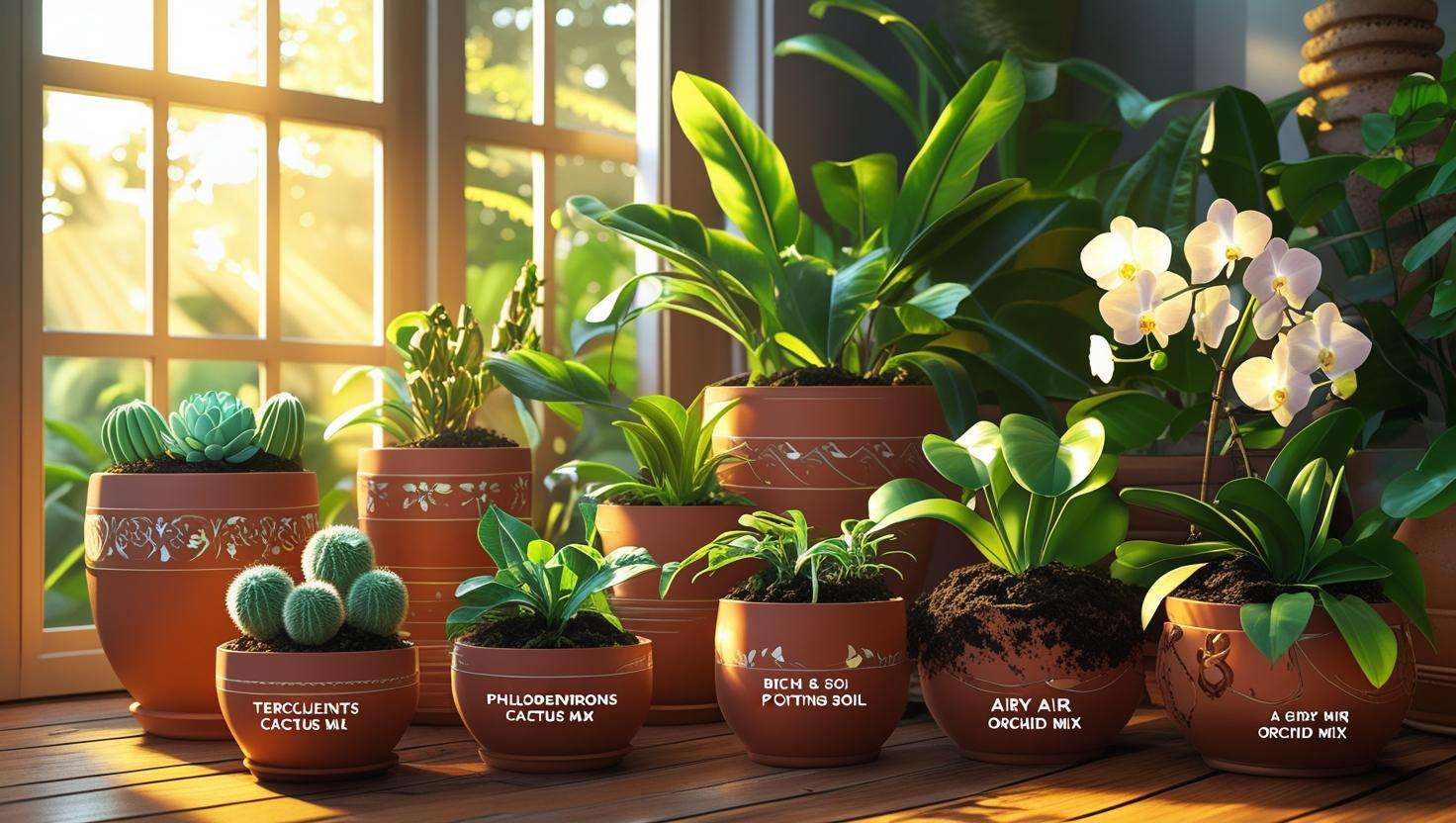
How to Choose the Perfect House Plant Soil for Healthy, Thriving Plants for Healthy, Thriving Plants
Are your house plants struggling to thrive, no matter how much you water or sunlight they get? 🤔 The problem might be the soil! Choosing the right house plant soil is more crucial than many people realize. It’s not just about providing nutrients; it’s about creating the perfect environment that promotes healthy roots and encourages strong growth.
In this complete guide, we’ll walk you through everything you need to know to choose the ideal soil for your indoor plants, whether you’re a beginner or an experienced plant enthusiast. From understanding soil types to recognizing the signs of poor soil, this article will help you solve the mystery behind healthy house plants 🌿. Keep reading to give your greenery the foundation it deserves!
Table of Contents
Toggle1: Why House Plant Soil Matters 🌱
When it comes to house plants, choosing the right soil is just as important as watering or providing sunlight. In fact, soil is the foundation of your plant’s health. 🌿 Without the right soil, even the most dedicated plant parent will struggle to keep their plants thriving.
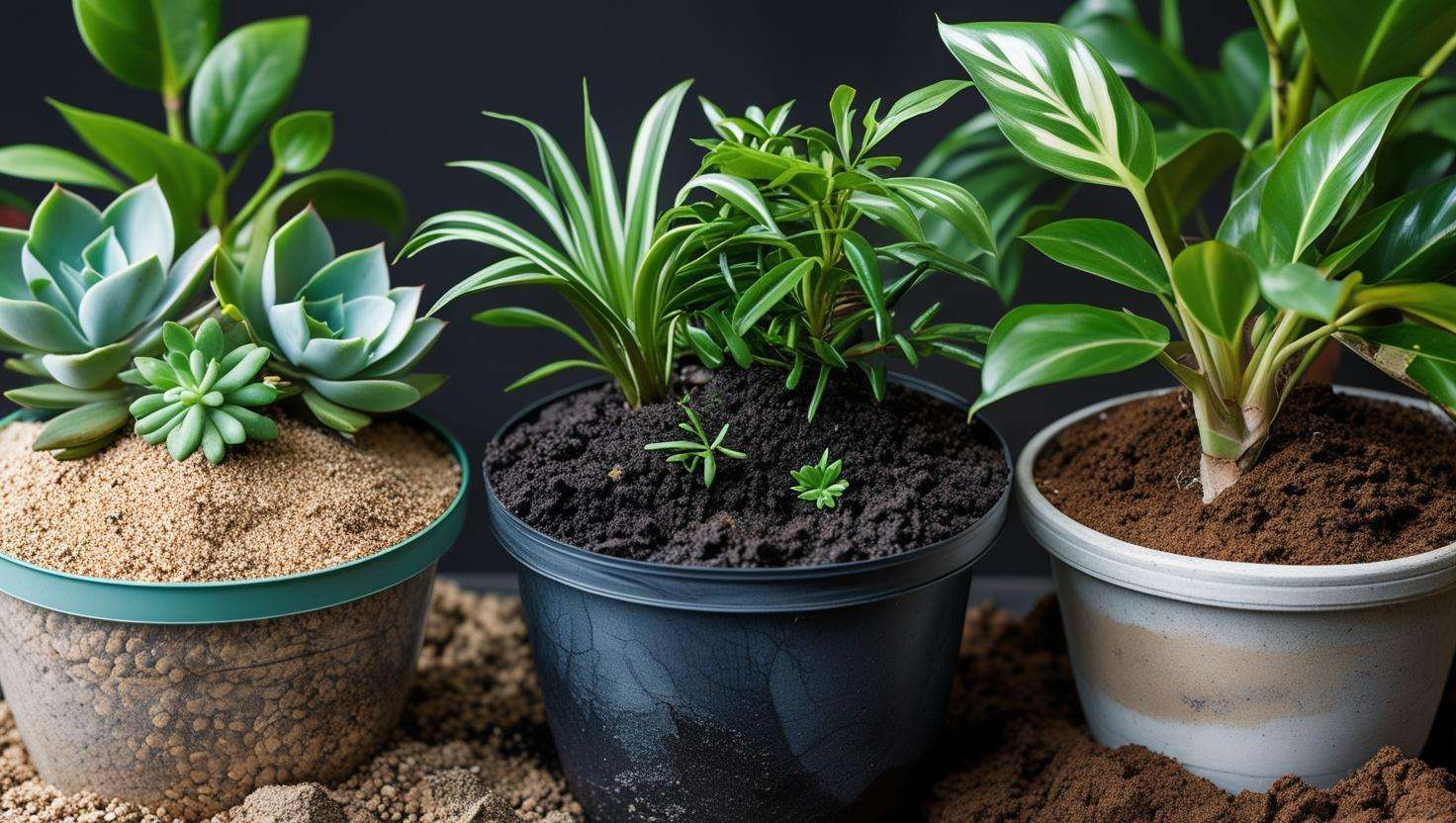
Here’s why soil matters so much:
- Nutrient Absorption: Soil provides essential nutrients that your plants need to grow strong and healthy. From nitrogen to potassium, these nutrients help plants develop healthy leaves, flowers, and roots. A nutrient-rich soil can give your plants the boost they need to reach their full potential.
- Root Health: Good soil supports healthy root growth. If your soil is too dense or poorly drained, it can suffocate the roots, causing rot and stunted growth. Proper soil allows roots to breathe and access the moisture and nutrients they need.
- Water Retention & Drainage: Different plants need different levels of moisture. A good house plant soil mix balances water retention with proper drainage. While tropical plants might love a soil that retains moisture, succulents and cacti prefer a well-draining mix to avoid waterlogging. Finding the right balance helps prevent issues like root rot or dehydration.
- Aeration: Healthy soil allows for air circulation around the roots. If the soil is too compact, roots can’t get the oxygen they need to survive, leading to weak or dying plants. Properly aerated soil ensures that your plants’ roots stay happy and healthy.
- pH Balance: The pH level of your soil can also affect plant health. Some plants thrive in slightly acidic soil, while others prefer it more alkaline. If your soil’s pH is off, your plant might have trouble absorbing the nutrients it needs, leading to yellowing leaves or slow growth.
Choosing the right soil isn’t just about convenience; it’s about creating the perfect environment for your plants to flourish. So, whether you’re caring for a lush fern, a hardy succulent, or a beautiful orchid, the soil you choose is crucial to their success. 🌿🌞
In the next section, we’ll break down the different types of house plant soils and how to pick the right one for your plants. Stay tuned!
2: Types of House Plant Soil
Choosing the right house plant soil is crucial for plant health, and with so many types available, it can be tricky to know where to start. In this section, we’ll break down the most common types of soil and help you match each one to your plant’s specific needs. 🌱
1. Potting Soil 🏡
- What It Is: The most common soil used for indoor plants, potting soil is a well-balanced mix of ingredients designed for general plant care.
- Best For: Most houseplants, like pothos, peace lilies, and spider plants.
- Key Features:
- Light and fluffy texture that allows air to reach the roots.
- Retains moisture without becoming too soggy.
- Contains essential nutrients for general plant growth.
Tip: If you’re unsure what soil to use, potting soil is a safe, all-purpose option for your indoor plants.
2. Cactus and Succulent Mix 🌵
- What It Is: This type of soil is designed specifically for plants that need well-draining conditions, like cacti and succulents.
- Best For: Cacti, succulents (e.g., aloe vera, jade plant), and other drought-tolerant plants.
- Key Features:
- Drains quickly and doesn’t retain excess moisture.
- Contains sand or perlite to promote air circulation around the roots.
- Helps prevent root rot, which is common in plants that prefer dry conditions.
Tip: If you notice your succulent or cactus plants are getting too much moisture and developing root rot, switch to this mix for better drainage.
3. Orchid Mix 🌸
- What It Is: A special blend for orchids, orchid mix focuses on good airflow and moisture retention, which are key to keeping these plants happy.
- Best For: Orchids and other air-loving plants.
- Key Features:
- Contains bark, sphagnum moss, and sometimes perlite to allow air to reach the roots.
- Excellent at holding moisture without becoming waterlogged.
- Lightweight, so it won’t suffocate delicate orchid roots.
Tip: Orchids need good airflow around their roots to thrive, so using an orchid-specific mix will help avoid common issues like root rot and poor flowering.
4. Peat-Free Soil 🌍
- What It Is: Eco-conscious gardeners are increasingly turning to peat-free soil options, which avoid the environmental damage caused by peat harvesting.
- Best For: A variety of plants, including most houseplants and flowering plants.
- Key Features:
- Often made from coconut coir, compost, and other renewable resources.
- Retains moisture well while still providing good drainage.
- Provides a sustainable alternative to peat-based mixes.
Tip: If you’re focused on sustainability, peat-free soil is a great option that works well for a wide range of plants.
5. Hydroponic Mix 🌊
- What It Is: This mix is designed for plants grown in water, without soil, through a hydroponic system.
- Best For: Hydroponic gardening or growing in water-based systems like aquaponics.
- Key Features:
- Made with materials like clay pebbles or perlite that allow for water and nutrients to circulate around plant roots.
- Supports plant roots in a hydroponic environment, providing stability and nutrient access.
- Great for growing leafy greens, herbs, and some vegetables indoors.
Tip: Hydroponic growing can be a fun way to grow plants indoors if you have the right setup. If you’re just getting started with hydroponics, this mix is essential.
3.Choosing the Right Soil for Your Plants
Each type of soil is designed with specific plant needs in mind. To keep things simple, here’s a quick guide:
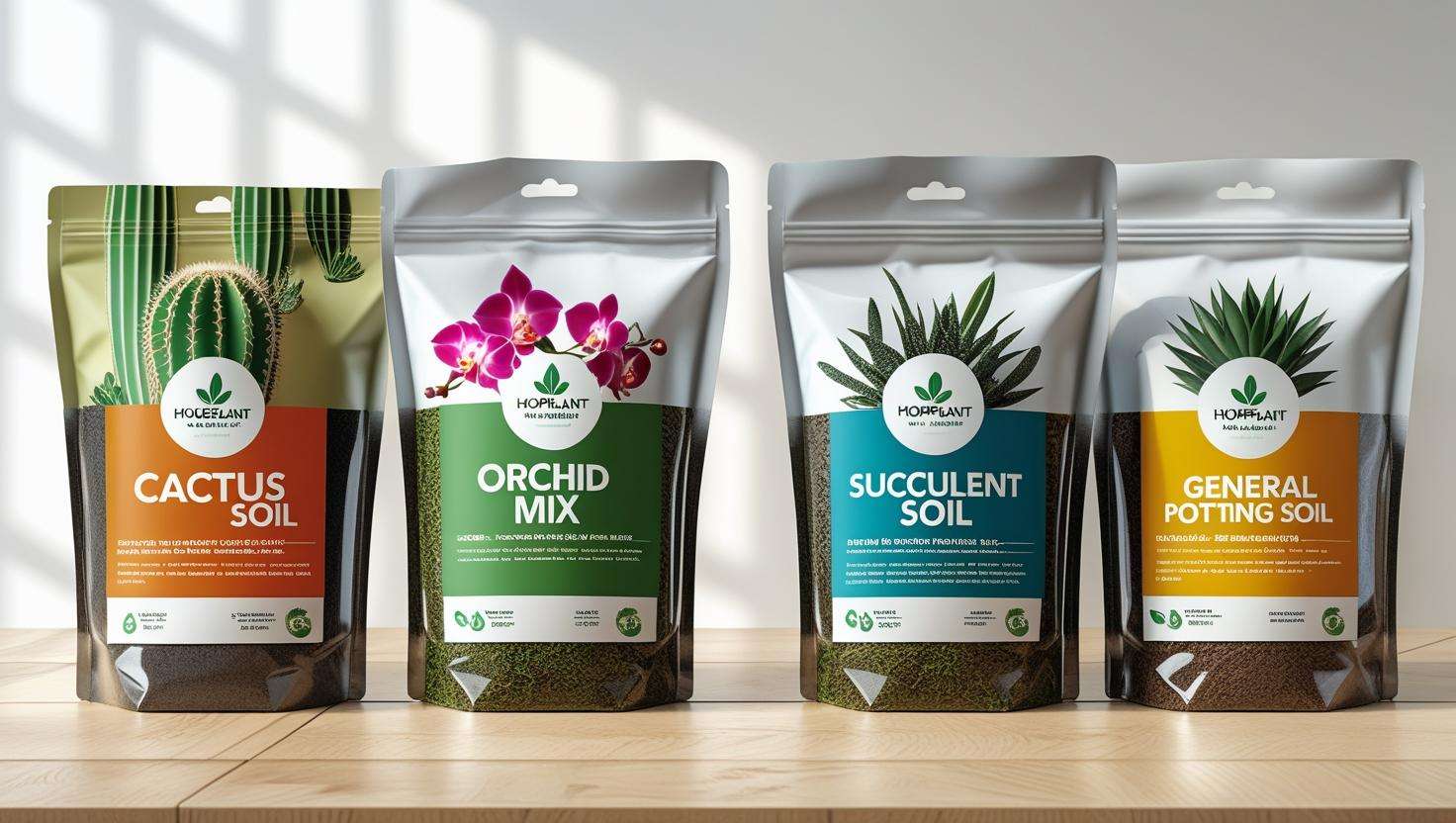
- Use potting soil for most houseplants.
- Opt for cactus/succulent mix if your plants need well-drained, dry conditions.
- Go with orchid mix for orchids and air-loving plants.
- Choose peat-free soil if you’re looking for an eco-friendly option.
- Select hydroponic mix if you’re experimenting with water-based plant care.
By understanding these soil types, you’ll be equipped to choose the right one for your plants, ensuring they have the best conditions to grow and thrive! 🌿
4.Key Factors to Consider When Choosing Soil 🌱
Choosing the right house plant soil can feel overwhelming with all the options out there. But once you understand a few key factors, selecting the perfect soil for your plants becomes much easier. Let’s break down what you need to consider to ensure your plants stay healthy and thrive. 🌿
1. Plant Type: Match Soil to Your Plant’s Needs 🌸
Different plants have different needs when it comes to soil. Understanding your plant type is the first step in selecting the right soil.
- Tropical Plants (e.g., peace lilies, ferns): These plants prefer soil that retains moisture but also drains well to prevent root rot. Look for a well-draining, moisture-retaining mix.
- Cacti and Succulents: These plants thrive in dry conditions, so they need soil that drains quickly and doesn’t hold excess water. A cactus mix or succulent mix will work best.
- Orchids: Orchids require a special orchid mix made from bark and other materials that allow for air circulation around the roots.
🔑 Tip: Research your plant’s specific needs or check the label of pre-packaged mixes to find the right one!
2. Moisture Requirements: How Much Water Does Your Plant Need? 💧
Plants have varying moisture needs, so it’s important to choose soil that complements how much water your plant prefers.
- Moisture-loving plants (e.g., spider plants, pothos) need soil that holds water without becoming waterlogged. A soil mix with peat moss or coconut coir helps retain moisture.
- Drought-tolerant plants (e.g., succulents, snake plants) need soil that drains quickly. Look for perlite, sand, or lava rocks in the mix to ensure good drainage.
💡 Actionable Insight: If you’re unsure, check the plant’s soil preference before selecting a mix. Too much water retention can lead to root rot for plants that don’t need it!
3. Drainage: Prevent Root Rot with Proper Drainage 🛑
Good drainage is crucial to plant health. Even moisture-loving plants need soil that doesn’t stay soggy for too long. Poor drainage leads to root rot, which is one of the most common plant problems.
- Drainage holes in your pot are a must! Without them, water can’t escape and can cause the roots to drown.
- Make sure the soil you use also has good drainage properties. A mix with perlite or vermiculite improves aeration and helps excess water flow through easily.
💧 Pro Tip: If you’re unsure about your soil’s drainage, test it by watering and checking if the water drains out within a few minutes.
4. pH Level: Plants Have Preferred pH Ranges ⚖️
Soil pH plays a role in how well plants absorb nutrients. Most indoor plants prefer a slightly acidic to neutral pH (around 6.0 to 7.0), but some plants may require more specific pH levels.
- Acid-loving plants (e.g., blueberries, azaleas) thrive in more acidic soils with a pH below 6.
- Alkaline-loving plants (e.g., lavender, lilacs) need soil with a higher pH, closer to 7.0 or above.
🔬 Tip: If you’re growing a specific plant that requires a particular pH, check the soil mix label or consider testing the pH level of your soil.
5. Nutrient Content: Fertilization Needs 🌾
Nutrients in soil provide plants with the building blocks they need for growth. Some plants are nutrient-hungry, while others can thrive in less fertile soil.
- Nutrient-rich mixes contain slow-release fertilizers, which are great for plants that need consistent feeding, like tomatoes or indoor herbs.
- Low-nutrient mixes are perfect for cacti, succulents, and orchids, which prefer to be fed sparingly.
⚡ Quick Tip: If you’re repotting, look for a soil mix that contains some slow-release nutrients to keep your plants happy long-term.
In Summary:
- Plant Type: Match soil with your plant’s moisture and drainage needs.
- Moisture Requirements: Choose moisture-retaining soil for thirsty plants and well-draining soil for drought-tolerant ones.
- Drainage: Ensure good drainage to prevent root rot.
- pH Level: Consider the pH preference of your plant.
- Nutrient Content: Select soil based on your plant’s need for nutrients.
By understanding these key factors, you’ll have the knowledge to choose the perfect house plant soil for a healthy, thriving indoor garden. 🌟
4: How to Prepare and Amend Soil for Your House Plants
If you want your house plants to thrive, it’s essential to ensure that the soil they’re growing in is well-prepared and suited to their needs. Whether you’re starting with a pre-packaged potting mix or reusing old soil, knowing how to amend and enhance it will give your plants the foundation they need to grow strong and healthy 🌿. Let’s dive into how you can easily prepare and amend your soil for optimal plant care.
Amending Store-Bought Soil
Most potting mixes come ready to use, but sometimes they can benefit from a little tweaking to better suit your plant’s needs. Here are some common amendments you can use:
- Perlite: Adds aeration and improves drainage, which is crucial for plants that don’t like soggy roots (e.g., succulents or cacti). Simply mix in 10-30% perlite to the existing soil.
- Coconut Coir: Great for increasing moisture retention without making the soil too heavy. Ideal for tropical plants like ferns and peace lilies 🌱. You can add about 20% coconut coir to your mix.
- Compost: Organic compost provides nutrients and encourages healthy root development. Mix 15-25% compost into your potting mix for a nutrient boost.
- Sand: For better drainage, especially in dense soils. Just add about 10-20% sand, but make sure it’s coarse sand, not beach sand.
Creating Custom Soil Blends
Sometimes, you may want to go beyond store-bought mixes and create your own custom soil for specific plants. Here are a few easy recipes to follow based on plant needs:
- For Succulents and Cacti: Use 2 parts potting soil, 1 part perlite, and 1 part sand or pumice. This mix will allow for quick drainage and prevent root rot in plants that thrive in dry conditions.
- For Orchids: Orchids need a mix that allows air to reach their roots, so create a blend of 2 parts orchid bark, 1 part perlite, and 1 part coconut coir. This will ensure proper moisture retention and airflow.
- For Ferns and Tropical Plants: Mix 3 parts peat-based potting mix with 1 part perlite and 1 part coconut coir for a soil that holds moisture but drains well, perfect for plants that love humid environments 🌿.
Signs Your Soil Needs Improving
Even if you’ve used the right mix initially, over time your soil may need some attention. Here are a few signs that your soil needs to be amended or replaced:
- Compacted Soil: When the soil becomes too compacted, it restricts root growth and water drainage. If the soil feels hard or dry to the touch and water sits on top, it’s time to refresh it.
- Poor Drainage: If you notice that your plant’s leaves are yellowing or showing signs of root rot, the soil may be holding too much water. Improving drainage with perlite or sand is a quick fix.
- Nutrient Deficiency: If your plants aren’t growing as fast or the leaves look pale, the soil might be lacking nutrients. Adding compost or organic fertilizer will help rejuvenate the soil and promote healthier growth 🌱.
How to Repot and Refresh Old Soil
If you’re reusing old soil from a previous plant, it’s important to refresh it before adding a new plant. Here’s a simple process:
- Remove Old Roots: Gently shake off any old plant roots from the soil. If the soil looks too compacted, gently fluff it up with your fingers.
- Add Fresh Amendments: Based on the type of plant you’re repotting, add appropriate amendments (perlite for drainage, compost for nutrients, etc.).
- Check the pH: Some plants prefer slightly acidic or alkaline soil. You can test the pH level of the soil with a simple pH test kit to ensure it’s in the optimal range for your plant.
- Repot: Once you’ve amended the soil, repot your plant, ensuring that the roots are well-covered but not too tightly packed. Water thoroughly after repotting to settle the soil.
Pro Tip for Soil Care
Regularly check your plants for signs of soil issues. Healthy, thriving plants start with a healthy soil environment. Refreshing your soil once a year (or as needed) will prevent problems and keep your plants happy 🌱.
By taking the time to properly amend and prepare your house plant soil, you’re setting your plants up for success. Whether you’re using store-bought mixes or creating your own blends, the right soil can help ensure your plants get the nutrients, drainage, and air circulation they need to grow strong and beautiful. Happy planting! 🌿😊
5: Common Mistakes to Avoid When Choosing House Plant Soil
Choosing the right house plant soil can be tricky, especially if you’re new to plant care. While it may seem straightforward, many common mistakes can lead to stressed-out plants or poor growth. Here are the top mistakes to avoid, along with practical tips to ensure your plants thrive 🌱.
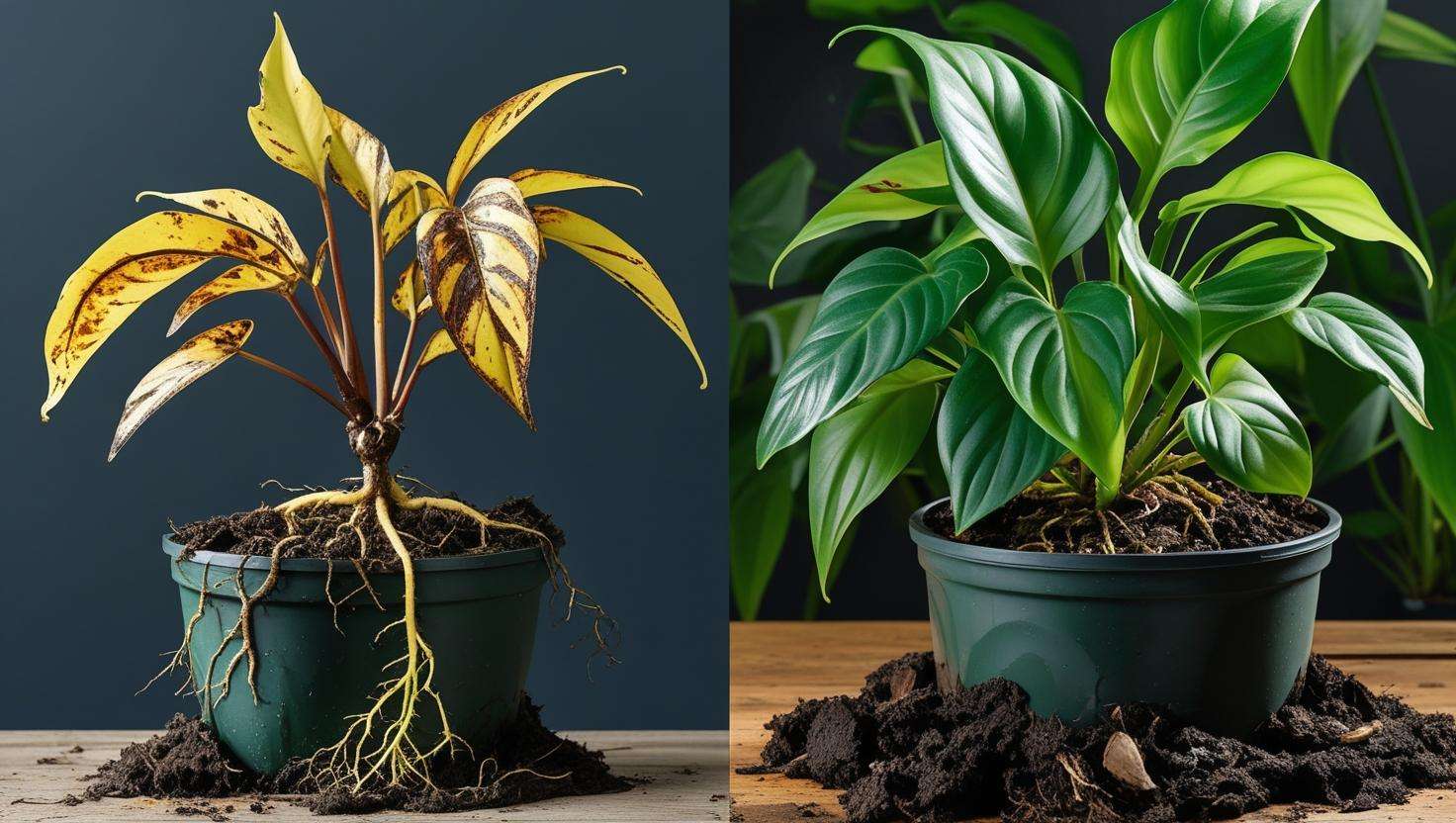
1. Using the Wrong Soil for Your Plant
One of the biggest mistakes is using the wrong type of soil for your plant’s needs. Not all plants like the same soil conditions! 🌿
- Cactus and succulents need soil that drains well and doesn’t retain too much moisture. A regular potting mix can be too dense and cause root rot.
- Tropical plants, like ferns and peace lilies, thrive in soil that holds more moisture and offers better aeration. A cactus mix would leave them dry and unhappy.
Tip: Always match the soil to your plant’s needs. Do a quick search or check plant care guides to ensure you’re using the right soil type for your specific plant.
2. Overwatering Due to Poor Drainage
Soil that doesn’t drain well can trap excess water, leading to waterlogged roots and potential root rot 🛑. Even the best potting soil can be problematic if it’s too dense or lacks sufficient drainage.
- Signs of poor drainage: Water sitting on top of the soil or slow water absorption.
- Solution: Opt for a soil mix with ingredients like perlite or sand that improve drainage. Also, always use a pot with drainage holes!
Tip: For plants that require well-draining soil, add perlite or a similar material to the mix to ensure the water flows freely.
3. Not Refreshing or Replacing Soil Regularly
Even the best soil can lose its structure and nutrients over time. Plants that have been in the same potting mix for a year or more might start showing signs of stunted growth or yellowing leaves.
Why it happens: Soil loses its ability to hold nutrients, and over time, it can become compacted, which affects root health.
Tip: Plan to refresh or replace the soil every 1-2 years, especially if your plant has outgrown its pot or the soil appears compacted. This helps your plants get the nutrients they need to grow strong and healthy.
4. Ignoring Soil pH
Not every plant prefers the same pH level in its soil! Some plants do better in slightly acidic soil, while others thrive in alkaline conditions. 🌿
- Acid-loving plants, like blueberries and azaleas, require a more acidic pH.
- Alkaline-loving plants, such as lavender, prefer more basic soil.
Tip: Research your plant’s pH preference. If you’re unsure, you can purchase a simple soil pH testing kit to find out the current pH of your soil. Adjust the soil as needed with additives like lime for alkalinity or sulfur for acidity.
5. Not Considering the Environment
Soil needs can also change based on where your plants are kept. Indoor environments are different from outdoor ones, and factors like humidity, temperature, and lighting affect your soil’s performance.
- Indoor plants often need soil that retains moisture, especially if your home is dry or uses air conditioning.
- Outdoor plants typically do well with soil that can handle more variable conditions like fluctuating temperatures and rainfall.
Tip: Consider the environment your plant is in when choosing soil. For example, house plants in drier climates may need soil that holds more moisture, while those in humid areas might benefit from a mix that drains faster.
6: How to Tell If Your House Plant Soil Needs to Be Replaced
Over time, the soil in your house plant pots can become less effective, impacting plant health. Here are the key signs that it’s time to refresh or replace your house plant soil:
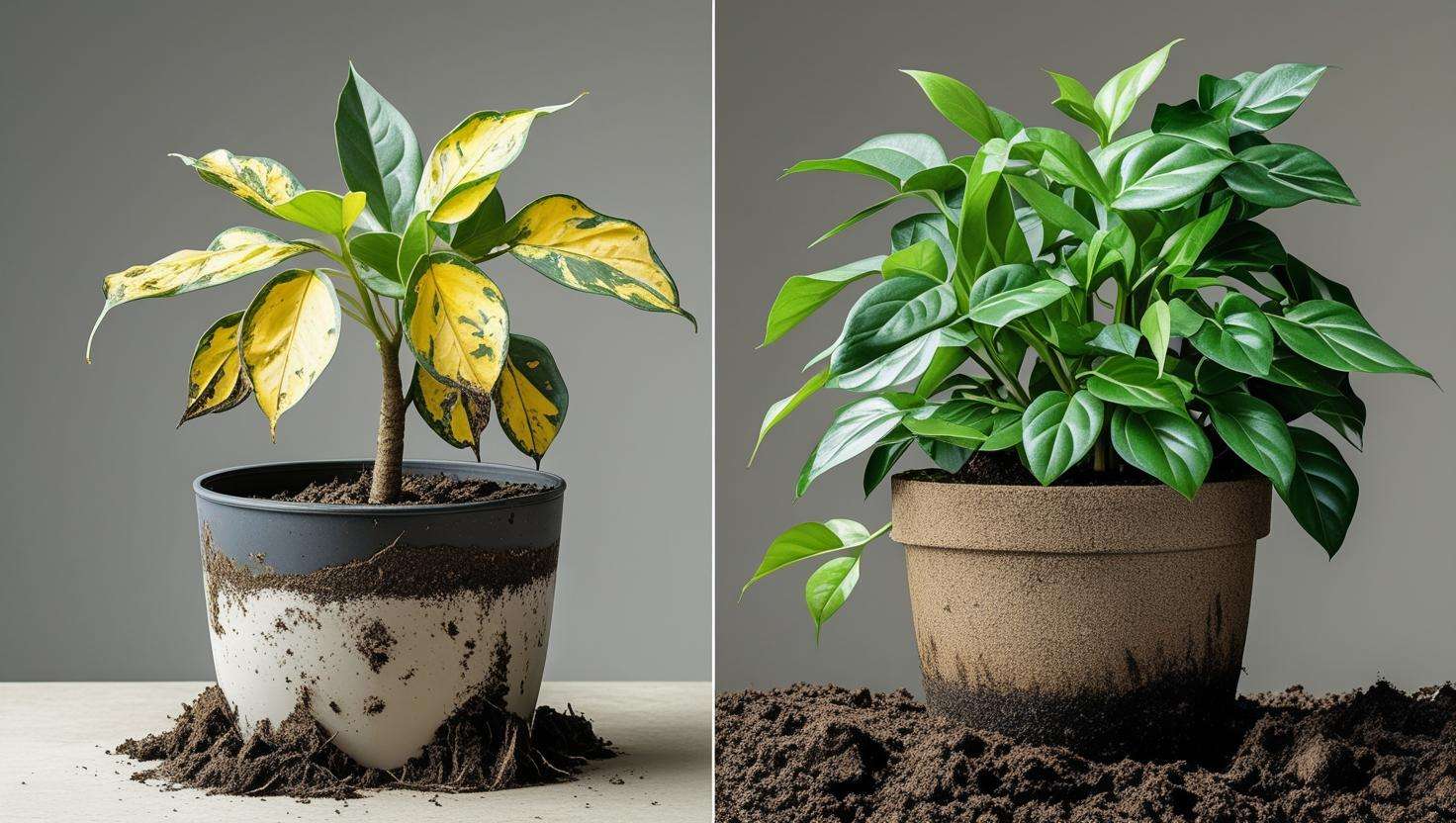
1. Soil Compaction 🏋️♂️
If the soil looks packed down and doesn’t fluff up when touched, it’s a sign of compaction. When soil compacts, it restricts root growth and makes it harder for your plant to absorb water and nutrients.
- What to do: Gently tap the sides of the pot to loosen the soil or replace it entirely with fresh, well-draining soil.
2. Poor Drainage 💧
Water should drain freely from the bottom of the pot after watering. If you notice water sitting on top or taking a long time to drain, your soil might be too dense or clogged.
- What to do: Replace old soil with a mix that offers better drainage. For plants that need quick drainage, try adding perlite or sand.
3. Nutrient Depletion ⚡
Plants need a constant supply of nutrients to grow, and old soil can lose its nutrient value over time. Signs of nutrient depletion include yellowing leaves, stunted growth, or leaves that drop off.
- What to do: If your plant shows these symptoms, refresh the soil with one that has a balanced nutrient content or add a slow-release fertilizer.
4. Root Bound Plants 🌿
If you see roots growing out of the drainage holes or the soil feels like it’s tightly packed around the roots, your plant may be “root bound.” This occurs when the roots have outgrown the pot and are unable to spread or absorb water properly.
- What to do: Repot your plant into a larger container with fresh, loose soil that allows the roots to breathe.
5. Fungal or Pest Infestation 🦟
Sometimes, pests like fungus gnats or mold can settle into the soil, causing trouble for your plants. If you notice tiny bugs or an unusual smell around the base of the plant, it’s a sign the soil might be harboring pests.
- What to do: Replace the soil entirely and disinfect the pot before repotting with fresh, pest-free soil.
6. Soil Smell 🤢
Healthy soil should have a clean, earthy smell. If your soil starts to smell sour or like rotten eggs, this could be an indication of stagnant water or root rot.
- What to do: Replace the soil and check for any signs of root rot, trimming away any affected roots before replanting.
Healthy Plants Start with the Right Soil 🌱
Choosing the perfect house plant soil is one of the most important steps in ensuring your plants thrive. By understanding the different soil types, recognizing the signs that your soil needs to be replaced, and making informed choices based on your plant’s needs, you can create an environment where your greenery can flourish.
Remember, the right soil isn’t just about nutrients—it’s about ensuring proper drainage, moisture levels, and root health. Whether you’re a beginner or an experienced plant owner, following these tips will help you keep your plants healthy, vibrant, and growing strong 🌿.
So, take a closer look at your plants, evaluate their soil, and make any necessary adjustments. Your plants will thank you for it with lush, healthy growth! Happy planting! 🌱✨
FAQs: How to Choose the Perfect House Plant Soil for Healthy, Thriving Plants
1. What type of soil is best for house plants?
The best soil for house plants depends on the plant’s specific needs. Most indoor plants thrive in well-draining, lightweight potting soil, but certain plants like succulents require a cactus mix, while orchids do better in a specialized orchid mix. Always choose soil based on your plant’s moisture and drainage needs.
2. Can I use garden soil for my house plants?
It’s not recommended to use garden soil for house plants. Garden soil is often too heavy, can contain pests, and doesn’t drain well, which can lead to root rot. Opt for a potting mix designed specifically for indoor plants.
3. How often should I replace the soil in my house plants?
You should replace the soil in your house plants every 1-2 years or when you notice signs of soil compaction, poor drainage, or nutrient depletion. Fresh soil will help support healthy root growth and prevent plant problems.
4. How can I tell if my plant’s soil needs to be replaced?
Signs that your plant’s soil needs replacement include poor drainage, yellowing leaves, root-bound conditions, a foul smell, or the presence of pests like fungus gnats. If you notice any of these issues, it’s time to refresh the soil for healthier growth.
5. Is it okay to mix different types of soil for house plants?
Yes, you can mix different types of soil to meet specific needs. For example, mixing regular potting soil with perlite or sand can improve drainage for plants that need drier conditions, while adding organic compost can boost nutrients for plants that require more feeding.
6. What is the difference between potting soil and compost for house plants?
Potting soil is a ready-to-use mix designed to provide the right balance of nutrients, drainage, and aeration for plant roots. Compost, on the other hand, is decomposed organic matter used to enrich the soil with additional nutrients. While potting soil is the primary growing medium, compost can be added to boost plant health.
7. Can I reuse old soil for my house plants?
Reusing old soil can be risky, as it may contain pests, diseases, or have lost its nutrient value. If you plan to reuse it, make sure to refresh it with new compost, perlite, or other amendments to restore its health and drainage capabilities.
8. Should I use soil with added fertilizer for my house plants?
Soil with added fertilizer can be beneficial for plants that require extra nutrients, but it’s important to choose the right fertilizer for your plant’s needs. Slow-release fertilizers are ideal for most house plants, while others may do better with occasional liquid feeding. Always check your plant’s requirements before adding fertilizers.
